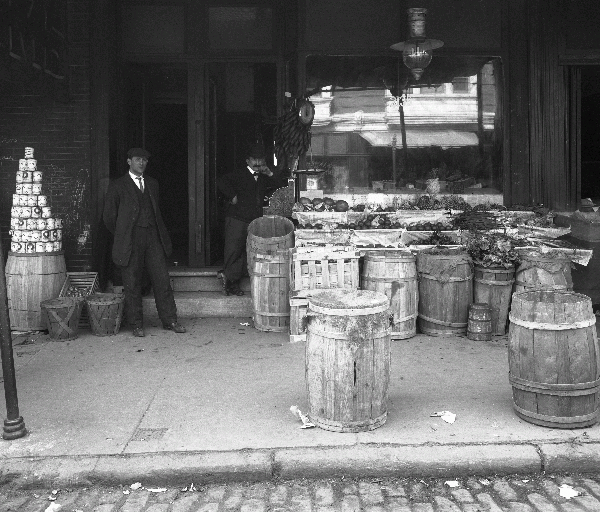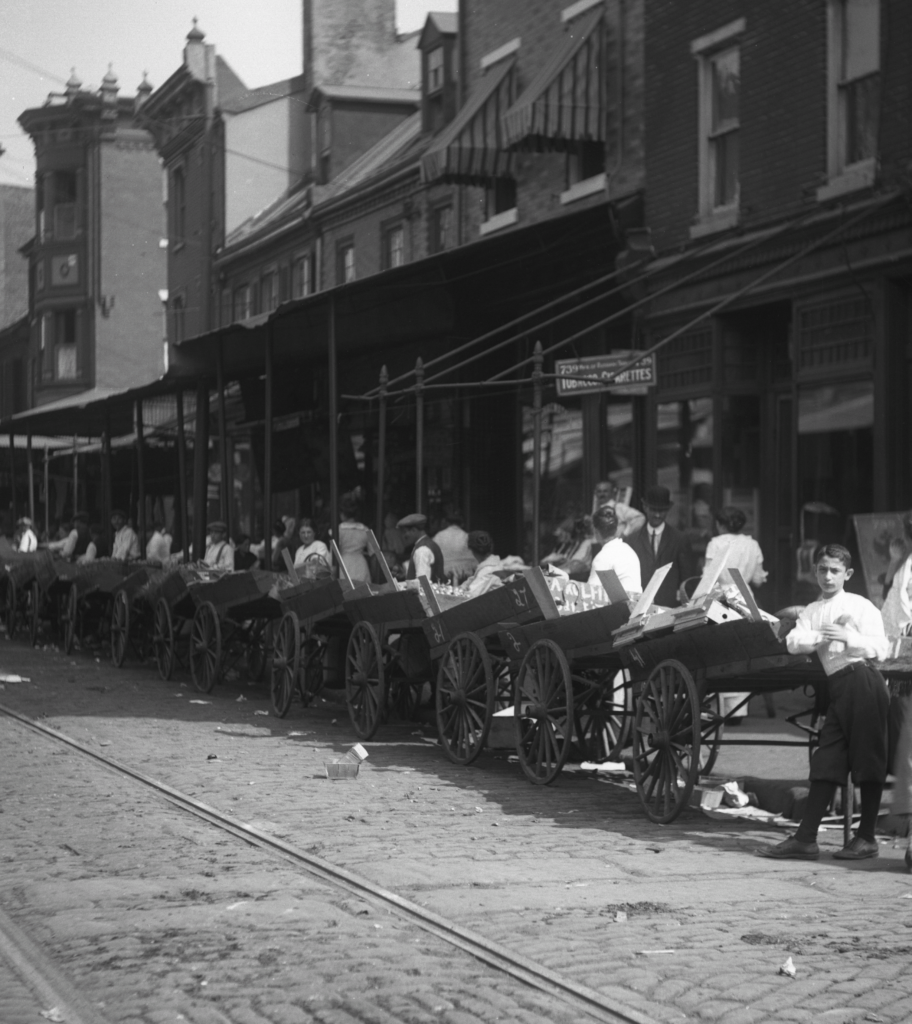Food prices had been spiraling out of control.
“Our children and our husbands are not getting enough to eat,” declared Pauline Goldberg, 27, of 449 Durfor Street in South Philadelphia. “It’s up to us to do something.”
Would that “something” be akin to New York City’s food riot? That started with a march on City Hall on February 20th with women from the Lower East Side chanting “Give us bread! We are starving! Feed our children!” Then, according to Marie Ganz, protesters turned violent on the profiteering street peddlers. “Cart after cart was overturned, and the pavements were covered with trampled goods. The women used their black shopping bags as clubs, striking savagely at the men… Onions, potatoes, cabbages flew through the air… Policemen came rushing upon the scene, and they, too, were pelted with whatever was at hand. Surely a thousand women — perhaps twice as many — were in that mad struggle.”
When the women of South Philadelphia learned about the “wave of food riots” that “swept over” New York “from the lower East Side all the way to Harlem,” they were primed for their own action. But “we are not going to raid shops or to riot,” promised Goldberg. “The riots in New York, have not influenced us in the least.”
“We do not expect to have to use force,” she told a reporter. “Already we have got in touch with about 500 women who have promised to cooperate with us. The others will have to cooperate with us. We are going to make them. No, I don’t think the police will interfere with us. They are pretty tired of paying high prices themselves.”

Up in Kensington, Catherine Ross Munro, aka “Mother Munro,” founder of the Cohocksink Mothers’ Club, concurred as to a peaceful approach. Munro drafted a telegram to Mayor Thomas B. Smith requesting his quick return home from vacation in Florida. “The working men’s wives of Kensington met at my home last evening and made an urgent appeal for aid to save their families from starvation,” it read. Munro, too, preferred respectful diplomacy: “The housewives of the northeastern section do not believe in rioting.”
But not all of the strikers agreed when they saw the price increases posted by vendors. Overnight, the price of carp jumped from 10 to 18 cents per pound. Onions rose from 2 1/2 to 14 cents. Word of this, and the knowledge that other shoppers who chose not to join the boycott were reduced to purchasing chicken heads for 15 cents each, and pairs of chicken feet 10 to 12 cents. “Even entrails were sold from the pushcarts and, apparently, were regarded by many of the poor as their only hope against starvation.”
All of this sent “several hundred Jewish women” in South Philadelphia over the edge. According to the Evening Public Ledger on February 22nd, crowds “swooped down upon push carts and invaded shops on Seventh street, above Morris, and attempted to destroy the wares. Intermittent battles between the housewives and food merchants raged until policeman were rushed to the scene and restored order. ‘It is robbery! Robbery! Robbery!‘ screamed the women, hurling the offending fish from their barrels and attempting to spoil the food by sprinkling kerosene upon it.”

“In the shop of Hyman Zebulsky, 1636 South Seventh street, the live carp were thrown against the walls and into the street. … In Louis Detofsky’s meat shop, at 1634 South Seventh Street., a more severe battle raged. Kerosene was thrown upon the floor in the melee and pint bottles of the oil, secreted about the women’s clothes, were broken. Outside the pushcarts of produce on the curb were overturned.”
“The spirit of open rebellion against food dealers” spread up and down 7th Street from Reed to Ritner; along 4th Street from Bainbridge to Snyder. Mobs of women “overturned push carts and threatened injury” and according to the Inquirer, “store owners were beaten and large quantities of food were destroyed.”
Organizers considered marching on City Hall, promised a crowd of 15,000 women.

“Rioting Won’t Help” advised an editorial headline in the Evening Public Ledger. But apparently it did help—getting the attention of City Hall and Harrisburg. Mayor Smith soon sanctioned a bill aimed at buying food and selling it at cost to ward off hunger. The legislature considered a “state-wide probe” as to the causes for exorbitant prices. The newspapers reported on speculators holding vast quantities of food in scores of railroad cars and warehouses. By the third week of March, the papers traced food price conspiracies” and the District Attorney promised intervention.
Progress—or so it seemed. Yet, disturbances continued a few days later when several hundred women attacked the food store owned by David Cohen at 4th and Mercy Streets, destroying its contents and assaulting the proprietor. Among those arrested: Pauline Goldberg, who, the newspaper reported, had “been arrested on the charge of rioting twice before in the last two weeks.”
“The problem of skyrocketing food prices was never really ‘solved,” explains labor historian William Frieburger, “it was simply absorbed into the far more catastrophic crisis.” President Woodrow Wilson made no reference to America’s food crisis in his second inaugural address on March 5th. Rather, he warned of the nation’s imminent entry into the “Great War” then raging in Europe. “To be indifferent to it, or independent of it, was out of the question,” declared Wilson. And in another month, the United States would enter the war, committing to sacrifices that included, but were hardly limited to, the nation’s food supplies.

[Sources: “Mob of Women Wails Protest on Food Costs,” Evening Public Ledger, February 20, 1917; “Food Riots Sweep Through New York, Ghetto to Harlem,” The Philadelphia Inquirer, February 21, 1917; “The New York Food Riots,“ The Philadelphia Inquirer, February 22, 1917; “Call Mayor Home In Crisis on Food,” Evening Public Ledger, February 22, 1917; “Rioting Won’t Help,“ Evening Public Ledger, February 22, 1917; “Women Destroy Food In Frantic War on Stores,” The Philadelphia Inquirer, February 23, 1917; “Relief For East from Food Stress Seen as West Speeds up Heavy Trains of Supplies,” Evening Public Ledger, February 23, 1917; “Mayor for Sale of Food at Cost,” Evening Public Ledger, February 26, 1917; “Promised Relief Halts Food Riots,” The Philadelphia Inquirer, February 27, 1917; “Food Speculation Bared in Patton’s Report to House,” The Philadelphia Inquirer, March 1, 1917; Says Speculators Hold Food in Cars, The Philadelphia Inquirer, , March 2, 1917; Food Riots Break Out in South Philadelphia,” The Philadelphia Inquirer, March 2,1917; Mayor Tells Plan for Cut-Rate Food,” The Philadelphia Inquirer, March 5, 1917; Food Price Probers Trace Conspiracies” The Philadelphia Inquirer, March 18, 1917; Marie Ganz, Rebels Into Anarchy—And Out Again, (New York: Dodd, Mead, and Company, 1919); “War prosperity and hunger: The New York food riots of 1917,” William Frieburger, Labor History, March 1984, Vol. 25, No. 2.]

One reply on “The South Philadelphia Food Riots of 1917”
What has changed?
How does, “Munro drafted a telegram to Mayor Thomas B. Smith requesting his quick return home from vacation in Florida” sound any different than our president golfing rather than addressing Covid relief, 103 years later?